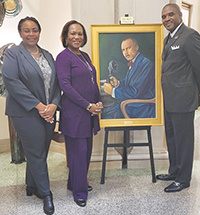
By St. Clair Murraine
Outlook Staff Writer
When former Florida legislator Tony Hill called Arnell Bryant Willis, diversity initiative manager for Florida Bar, he intended to have a fact-finding conversation.
By the end of the call about James Weldon Johnson, Bryant Willis found herself with an assignment to see how the Bar could pay homage to Johnson for being the first Black attorney to pass the Bar’s oral exam in 1898, a little-known fact about a very famous figure.
Among the many things that are known about Johnson is he was a key figure in the Harlem Renaissance era between 1891 and 1938. He was also a diplomat, publisher and had a lengthy affiliation with the NAACP, serving 10 years as executive secretary.
During the next six weeks or so, Tallahassee residents could learn more about Johnson, who is renowned for being the man who penned “Lift Every Voice and Sing,” better known as the Black National Anthem. Johnson’s portrait is one of five that is on display in the rotunda of the state Supreme Court, located at 500 South Duval Street.
The other notable attorneys featured in the exhibit include Judge Mario Goderich, James Kracht, Anna Brenner Meyers and Larry Smith.
A brochure in the court gives spectators a synopsis of each attorney’s career and the social issues they are known for advocating.
Johnson’s portrait is part of a traveling exhibit of Florida legal history project titled “Path to Unity.” It’s an illustration of the Florida Bar’s break from segregation to becoming a multi-cultural organization that makes inclusion part of its daily operation. The exhibit is simply titled “Legends.”
The exhibit was making its way around the state after opening in Jacksonville, Johnson’s home town, in the fall. Copies of the portraits made it to Daytona and Orlando before a second wave of COVID-19 hit and slowed the tour.
The Jacksonville event was highlighted by a Johnson documentary in which Hill appeared.
The Tallahassee stop features the original paintings.
“I never expected it to be where it is now in Black History Month,” Bryant Willis said. “It wasn’t planned that way. It just happened. We wanted it to come to the court, but we didn’t know that it was going to be here in the rotunda.”
The exhibit was originally featured in the library at the Supreme Court before moving to the rotunda, where the paintings sit on easels.
Hill, who served as a state representative and a senator from 1992 to 2011, said his interest in Johnson’s legacy goes beyond his accolades that also includes being on faculty at two different universities.
“I just have an affection for James Weldon Johnson and the contributions that he made,” said Hill, also a Jacksonville native.
His next major recognition for Johnson will take place on July 17, Hill said, when Maine’s Gov. Janet Mills is expected to issue a proclamation honoring the Jacksonville native. Johnson died in Wiscasset, Maine, after his car collided with a train.


Be the first to comment